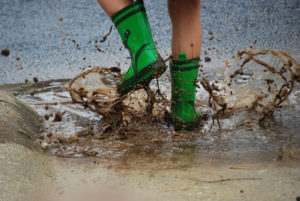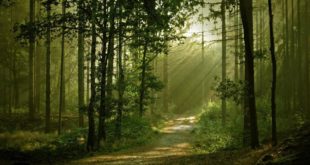 From A. A. Milne’s immortalization of “Poohsticks” to the popularity of today’s urban water slides, water play remains a fascinating and nearly universal childhood pastime. You may think of puddle-stomping as strictly a summer sport, but water in all its forms offers opportunities for play all year.
From A. A. Milne’s immortalization of “Poohsticks” to the popularity of today’s urban water slides, water play remains a fascinating and nearly universal childhood pastime. You may think of puddle-stomping as strictly a summer sport, but water in all its forms offers opportunities for play all year.
But It’s Wet Outside!
As every Montessorian knows, there’s no such thing as bad weather, merely inappropriate clothing. In winter, “appropriate” means layers and layers and layers, of course. Ah, snow: a fifteen minute-per-child button-up-and-buckle session – immediately followed by at least one request to visit the bathroom! Off come the gloves, the hat, the scarf, the parka, the snow pants, the jeans…
If getting the children outdoors in wet, winter weather seems hardly worth the trouble, consider that, for the young child, visiting familiar summer places in winter can be like visiting a different planet – the awesome visible changes brought about by the turning of the seasons are an exciting and wondrous mystery waiting to be solved.
This sense of wonder, and the insatiable curiosity it inspires, are keys to understanding why Montessori education works so well for children. Simply put, when children ask “Why?”, Montessori suggests we answer by helping children find the answer themselves.
Outdoor Activities for Late Winter/Early Spring
A detailed illustration of Montessori-style rain exploration follows. Still frozen in your part of the world? See more specific activities for wet, winter weather online. You can expand the same sequencing ideas to the activities listed for Winter Ponds, Puddles & Streams Great Ideas for Icy Outdoor Art & Science, and Snow Activities with More Fun & Less Ho-Hum.
Rain & Rainbows the Montessori Way
The first step is offering the experiences that ignite a child’s need to know. Inspired by observation and experience, children will dive into follow-up activities eagerly. Offer sequential resources that match your child’s interest and abilities.
Step 1. Direct Observation
Ages 3-5: When a rainbow comes your way, draw attention to the lovely colors in the sky. Respect the wonder of children’s first observations by waiting to offer explanations until the children themselves ask “Why?”.
Ages 6-9: Notice when older children begin to wonder how much rain is falling. The child may ask how rain is measured, or your only clue may be containers set strategically around the yard to catch the rain. – this is a rain gauge moment!
Step 2. Hands-On Activity
Ages 3-5: When the child asks “why?” or “how?”, a simple explanation paired with a follow-up question will keep your child moving along the path of inquiry. You might answer, “When sunlight moves through falling rain, we see all the colors of sunlight. Did you know all the rainbow colors are inside sunlight?” If the child is intrigued, show how to make a rainbow with a prism – an amazing “trick” children will repeat, trying different light sources and different angles. Then, you might introduce a color mixing activity: transparent overlays (a card material or a book) that reveal secondary colors when children layer primary colors, or perhaps a hands-on activity blending drops of food coloring and water.
Ages 6-9: Measuring the rain is the kind of ongoing hands-on experiment older children enjoy. Daily records require daily maintenance, which means a daily outing to record readings and empty the gauge – what fun! Daily rainfall can be charted or graphed over time. Home measurements can also be compared to local meteorological predictions and records.
Step 3. Follow-Up Resources
Ages 3-5: Photo-format books that give children an overview of seasons and weather, and related vocabulary, come first. Montessori reminded us in From Childhood to Adolescence that “…to teach details is to bring confusion. To establish relationships between things is to bring knowledge..” After offering books about seasons and weather, then turn to the details of rain, rainbows, and sunlight. Later, after the child’s understanding has grown, make the prism or color mixing activity available again, so the child can apply new ideas and words to a familiar activity.
Ages 6-9: Older children need the big picture first, too; however, they’ll enjoy a weather book with more scientific detail and lots of astounding facts. Let the child’s interest determine which detail to follow up on. If the statistics of rain are all he talks about, offer a book with regional or global meteorological data of all kinds. When fussing with the gauge itself is her interest, a book with instructions for building and using a variety of meteorological instruments may be in order. Is what happens to all the water his passion? Try a book about the water cycle, or about how plants and people use water.
Outdoor Activities for Late Winter/Early Spring
A detailed illustration of Montessori-style rain exploration follows. Still frozen in your part of the world? See more specific activities for wet, winter weather online. You can expand the same sequencing ideas to the activities listed for Winter Ponds, Puddles & Streams Great Ideas for Icy Outdoor Art & Science, and Snow Activities with More Fun & Less Ho-Hum.
 Montessori blog Montessori blog
Montessori blog Montessori blog 
